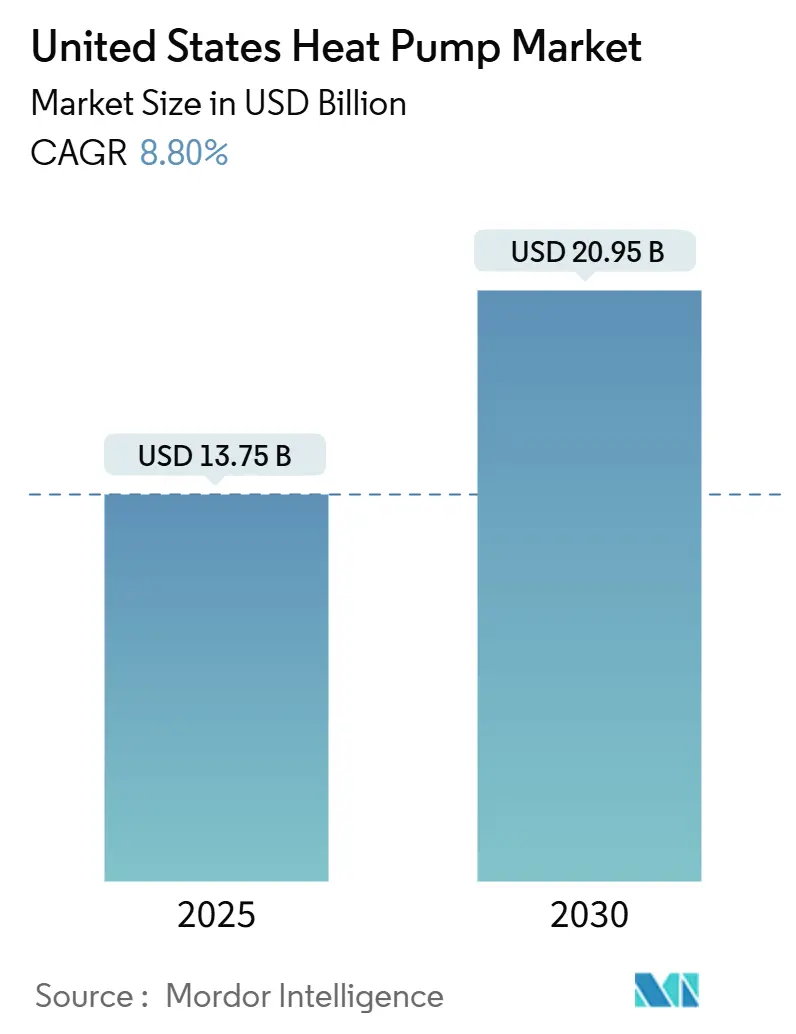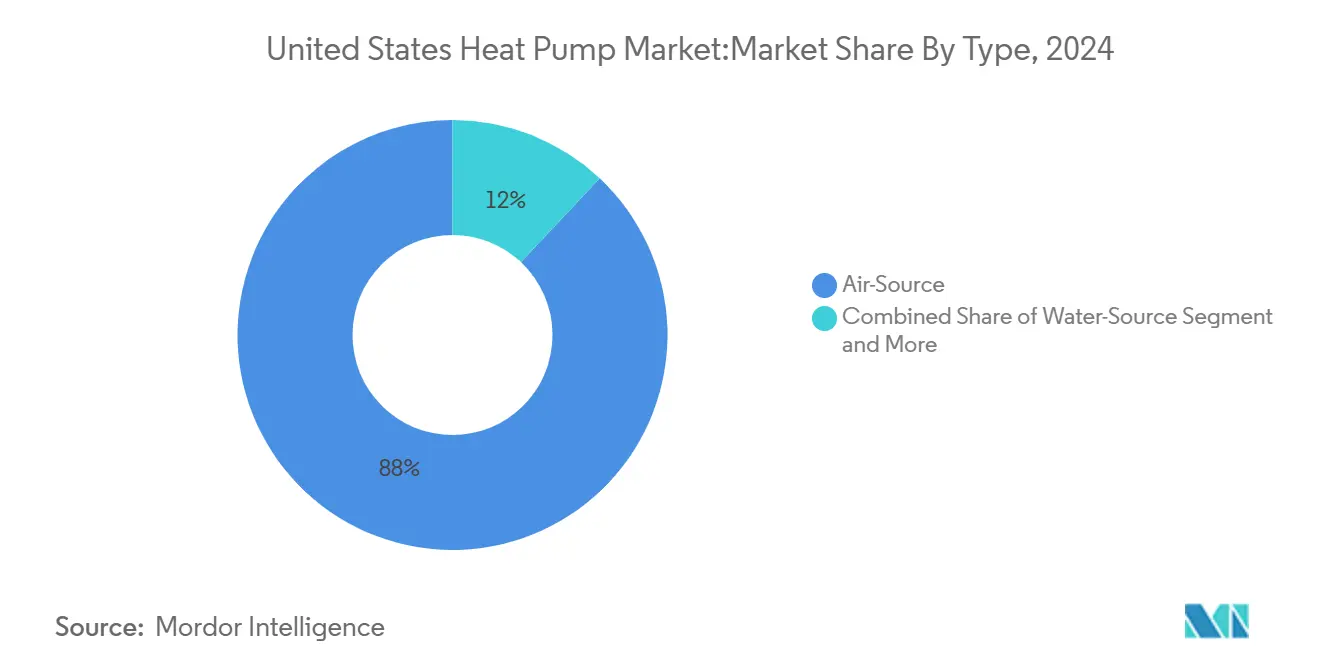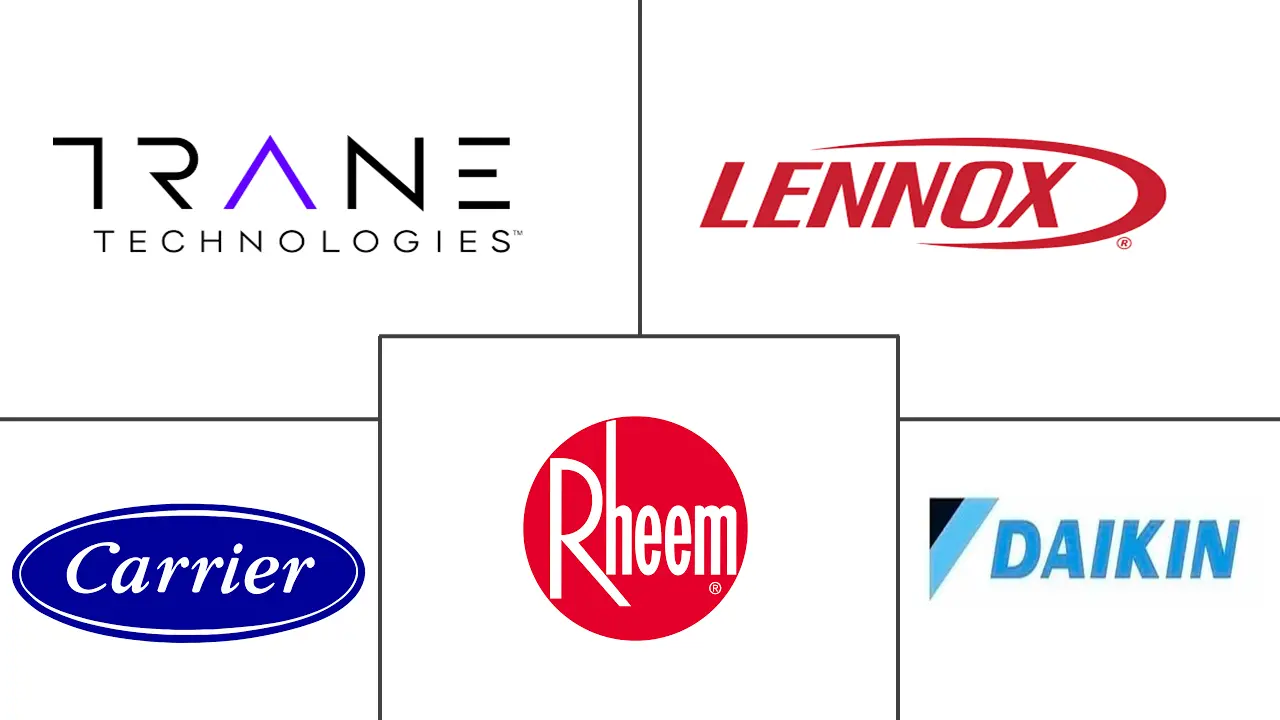
United States Heat Pump Market Analysis by Mordor Intelligence
The US heat pump market size was USD 13.75 billion in 2025 and is projected to reach USD 20.95 billion by 2030, growing at an 8.80% CAGR over the forecast period. Federal tax incentives, accelerated refrigerant phase-down rules, and state electrification mandates are reshaping the competitive landscape as consumers and businesses transition from combustion-based HVAC systems to high-efficiency electric alternatives. Policy support aligns with breakthroughs in cold-climate technology, enabling full-capacity operation at 0°F and unlocking northern markets that have historically favored gas furnaces. Manufacturers are bringing compressor production on-shore to contain logistics risk and shorten lead times, while natural-refrigerant designs are moving out of R&D and into commercial catalogs. At the same time, installer shortages, legacy electric panels, and rising borrowing costs moderate the near-term growth curve, reinforcing the importance of channel strategy and workforce development.
Key Report Takeaways
- By type, air-source systems held 88% revenue share of the United States heat pump market in 2024; ground-source units are projected to deliver the fastest growth at a 9.8% CAGR through 2030.
- By capacity, units with a capacity of ≤ 5 tons captured 72% of the United States heat pump market share in 2024; units with a capacity of >10 tons are set to expand at a 10.5% CAGR to 2030.
- By end user, residential applications accounted for 90.5% of the United States heat pump market size in 2024, while industrial systems are projected to grow at a 9.2% CAGR.
- By refrigerant, R-410A commanded 90% share of the United States heat pump market in 2024; natural alternatives are forecast to rise at 9.0% CAGR.
- By region, the South led the United States heat pump market, accounting for 59% of the market size in 2024, while the Northeast posted the highest regional CAGR at 10.1%.
United States Heat Pump Market Trends and Insights
Drivers Impact Analysis
| Driver | (~) % Impact on CAGR Forecast | Geographic Relevance | Impact Timeline |
|---|---|---|---|
| Federal tax incentives under Inflation Reduction Act | +2.1% | National; stronger in high-income areas | Medium term (2-4 years) |
| Rapid high-GWP refrigerant phase-down | +1.8% | National; earliest compliance in California | Short term (≤ 2 years) |
| Expanding state electrification mandates | +1.5% | Northeast, West Coast, spreading to Midwest | Long term (≥ 4 years) |
| Cold-climate performance breakthroughs | +1.2% | Northeast, Midwest, Mountain West | Medium term (2-4 years) |
| Heat-pump water-heater rebates | +0.9% | Nationwide; program design varies by state | Medium term (2-4 years) |
| OEM on-shoring of compressor manufacturing | +0.7% | Production hubs in the Southeast | Long term (≥ 4 years) |
| Source: Mordor Intelligence | |||
Federal Tax Incentives Under Inflation Reduction Act Boost Adoption
Thirty-percent tax credits (capped at USD 2,000) and point-of-sale rebates up to USD 8,000 have pushed heat pumps into cost parity with gas furnaces for a large share of U.S. homeowners Income-qualified rebates covering heat-pump water heaters add a second entry point that reduces customer-acquisition cost for OEMs. Unit sales surpassed gas furnaces for the third straight year in 2024, rising 27% year over year. Premium models with variable-speed compressors continue gaining traction as incentives offset the price gap, enabling manufacturers to protect margins while broadening addressable demand.
Rapid Phasedown of High-GWP Refrigerants Accelerates Equipment Refresh Cycles
EPA rules ban refrigerants above 700 GWP in new comfort-cooling equipment beginning January 2025, forcing manufacturers to redesign platforms around A2L blends such as R-454B and R-32.[1]U.S. Environmental Protection Agency, “Phasedown of Hydrofluorocarbons: Restrictions on the Use of HFCs,” epa.gov A one-year sell-through window for R-410A systems ends December 2025, pulling forward replacement demand and contributing to double-digit price hikes on A2L-ready units. California’s earlier 2,200 GWP cap tightens supply for legacy refrigerants, creating micro-shortages that favor vendors with compliant stock and reclaimed-gas programs.
State-Level Electrification Mandates Expand Beyond Coastal States
Nine states plus the District of Columbia target 65% heat-pump share of new HVAC sales by 2030. New York’s All-Electric Buildings Act bans fossil-fuel systems in new low-rise construction starting 2026, while Washington’s 2024 code revisions tilt the baseline toward electric heating. These mandates concentrate on new builds where incremental cost is lowest and grid capacity sizing can be addressed in the design phase, positioning the US heat pump market for steady structural growth.
Cold-Climate Performance Breakthroughs Unlock Northern Demand
Through the DOE Cold Climate Heat Pump Challenge, multiple OEMs now market units that hold 100% heating capacity at 0 °F and operate reliably to −13 °F. Field trials across 22 sites verified year-round comfort with minimal strip-heat usage, demonstrating full electrification feasibility for homes that previously required dual-fuel setups.[2]Pacific Northwest National Laboratory, “Performance Results from DOE Cold Climate Heat Pump Challenge Field Validation,” pnnl.gov Performance credibility lowers perceived risk for contractors and regulators, catalyzing policy shifts in the Northeast and Upper Midwest.
Restraints Impact Analysis
| Restraint | (~) % Impact on CAGR Forecast | Geographic Relevance | Impact Timeline |
|---|---|---|---|
| Short-term refrigerant-transition supply bottlenecks | −1.4% | Nationwide; most acute in California | Short term (≤ 2 years) |
| Skilled-installer labor shortage | −2.2% | National; amplified in rural counties | Medium term (2-4 years) |
| Legacy-home electrical-panel limits | −1.1% | Northeast and Midwest older housing stock | Long term (≥ 4 years) |
| Rising interest rates | −0.8% | Nationwide; greatest on discretionary upgrades | Short term (≤ 2 years) |
| Source: Mordor Intelligence | |||
Skilled-Installer Labor Shortage Inflates Installation Costs
Annual HVAC vacancies exceed 42,500 positions as retirements outpace new entrants, pushing lead times to 8–12 weeks in several metro areas. Only one-quarter of technicians have advanced heat-pump accreditation, and A2L refrigerant certification adds another layer of complexity. Massachusetts committed USD 14.28 million to community-college training, but most states lack comparable funding, sustaining wage inflation that lifts installed cost and tempers US heat pump market growth.
Legacy-Home Electrical-Panel Limits Curb Addressable Market
Roughly 40% of U.S. dwellings operate on sub-200-amp service, requiring USD 2,000–5,000 panel upgrades before heat-pump installation can proceed. The Inflation Reduction Act offers USD 600 credits, but the gap remains significant for price-sensitive owners, especially in the Northeast’s pre-1960 housing stock. Smart-panel solutions can defer full upgrades yet demand specialized labor that is already in short supply, constraining near-term unit-addressability for the US heat pump market.
Segment Analysis
By Type: Air-Source Scale Meets Ground-Source Momentum
Air-source units controlled 88% of revenue in 2024, reflecting lower upfront cost and wide installer familiarity. However, ground-source systems post a 9.8% CAGR to 2030 as uncapped federal credits and community-loop models shrink capital barriers. Dandelion Energy’s 1,500-home Colorado development underscores mainstream builder acceptance Stable 50–60 °F ground temperatures translate to 400–500% efficiencies, raising lifecycle value even when installed cost runs higher than comparable air-source packages.
The US heat pump market size attributable to ground-source solutions is projected to rise from USD 1.6 billion in 2025 to USD 2.7 billion by 2030, while air-source revenues continue compounding on larger base volumes. Urban vertical-bore and shared-loop architectures unlock dense-housing applications once thought impractical, positioning geothermal as a disruptive contender in high-energy-price metros.

Note: Segment shares of all individual segments available upon report purchase
By Capacity: Residential Core, Commercial Upswing
Systems ≤5 tons satisfied 72% of installations in 2024, aligning with detached and attached single-family demand. The mid-range 5–10 ton band addresses multifamily assets and light commercial properties, but the fastest volume acceleration appears in >10-ton rooftop and modular systems, which clock a 10.5% CAGR through 2030. Commercial electrification targets and warehouse retrofits drive specification of large units that slash site CO₂ by up to 50% relative to gas-fired equipment.
US heat pump market share for >10-ton equipment is expected to climb from 6% in 2024 to 9% in 2030, giving OEMs scope to differentiate through factory-integrated controls, demand-response readiness, and simplified rigging kits that compress on-site labor time.
By End User: Residential Base, Industrial Inflection
Residential accounted for 90.5% of 2024 shipments, propelled by rebates and heightened consumer awareness. Commercial penetration receives a boost from corporate ESG commitments; however, the most potent long-term upside lies in industrial process heating, where a 9.2% CAGR is forecast as facilities utilize 140–200 °F waste-heat streams. Food, beverage, and chemical plants pilot high-temperature units that displace steam boilers, setting a precedent for broader adoption.
The US heat pump industry gains strategic depth by moving beyond comfort conditioning into thermal process loads, diversifying revenue streams, and fortifying order books against residential cycle fluctuations.
By Refrigerant: Transitional Blends to Natural Leadership
R-410A still accounted for 90% of the 2024 charge volume, but AIM-Act deadlines are pivoting engineering roadmaps toward A2L blends with 65% lower GWP. Bridge molecules such as R-32 preserve installer familiarity while OEMs complete redesigns around CO₂ and propane architectures. The natural-refrigerant US heat pump market's revenues are projected to rise at a 9.0% CAGR, capturing early mover goodwill among policy-driven buyers and sustainability-minded corporations.
The US heat pump market size for natural refrigerant-based equipment is accelerated by California procurement standards and DOE grant scoring that favors ultra-low-GWP solutions.

Note: Segment shares of all individual segments available upon report purchase
Geography Analysis
The South’s entrenched leadership stems from mild winters and high air-conditioning saturation, allowing heat pumps to serve dual roles with minimal incremental cost. Utilities such as SMUD layer rebates up to USD 2,000, further tipping payback math in favor of electrification. Alabama and South Carolina post some of the nation’s highest per-capita installation rates without formal climate mandates, illustrating economics-led adoption pathways that could repeat in other low-gas-price territories.
The Northeast experiences the strongest growth trajectory as cold-climate models and generous incentives converge. NYSERDA offers income-qualified rebates reaching USD 8,000, offsetting higher electric rates and legacy home retrofits. Massachusetts addresses workforce supply with a USD 14.28 million training fund that accelerates technician throughput. Policy clarity and predictable incentive stacking underpin contractor confidence, shortening sales cycles in states once considered marginal.
Midwest and Western states represent the next wave of expansion. The West’s environmental ethos, combined with tiered electricity tariffs, underwrites payback for high-SEER heat pumps even in cooling-dominant climates. The Midwest benefits from proof-of-concept data showing sustained capacity at −13 °F, but entrenched natural-gas infrastructure and conservative purchasing norms necessitate bundled offers that pair equipment financing with panel upgrades.
Competitive Landscape
The US heat pump market is moderately concentrated. The top five suppliers, Carrier, Daikin, Trane, Rheem, and Bosch, command a combined share of roughly 55–60%, with the remainder divided among Mitsubishi Electric, Lennox, Samsung, LG, and niche geothermal specialists. Competitive levers center on compressor IP, inverter-drive efficiency, and regionalized distribution depth rather than price-only tactics.
Vertical-integration plays are gathering pace: Daikin, Bitzer, Modine, and A.O. Smith secured USD 84.7 million in Defense Production Act support to localize compressor output, insulating supply chains from geopolitical risk and currency volatility.[3]U.S. Department of Energy, “Defense Production Act Heat Pump Program Selections,” energy.gov Bosch’s USD 8 billion acquisition of Johnson Controls’ residential HVAC arm delivers cross-regional synergy, combining European cold-climate know-how with U.S. dealer relationships.
Innovation investment tilts toward cold-climate algorithms, smart-grid connectivity, and natural-refrigerant safety engineering. DOE’s Commercial Heat Pump Accelerator convenes OEMs and property owners to validate >10-ton rooftop models in live environments, shortening commercialization cycles and de-risking capex for facility managers. First movers that field-prove A2L and natural-refrigerant portfolios stand to capture specification preference during the inevitable replacement surge post-2025.
United States Heat Pump Industry Leaders
-
Daikin Industries Ltd (incl. Goodman)
-
Trane Technologies plc
-
Rheem Manufacturing Company
-
Lennox International Inc.
-
Carrier Global Corporation
- *Disclaimer: Major Players sorted in no particular order

Recent Industry Developments
- April 2025: Dandelion Energy and Lennar announced a 1,500-home geothermal deployment projected to save USD 30 million over 20 years.
- April 2025: AAON introduced Alpha-Class commercial heat pumps maintaining 100% capacity at 5 °F.
- March 2025: California Heat Pump Partnership unveiled a blueprint for 6 million installations by 2030.
- February 2025: LG Electronics showcased cold-climate and low-GWP-ready models at AHR Expo 2025.
Research Methodology Framework and Report Scope
Market Definitions and Key Coverage
Our study counts every factory-built air, water, and ground-source heat pump that delivers space-conditioning or combined space and water heating in residential, commercial, and light industrial buildings across the fifty states. Systems shipped as part of packaged rooftop units or ductless splits are included, provided their primary function is heat transfer rather than process cooling.
Scope exclusion: stand-alone pool or spa heat-pump heaters, industrial dryers, and cryogenic refrigeration packages sit outside this market's boundary.
Segmentation Overview
- By Type
- Air-Source
- Water-Source
- Ground-Source (Geothermal)
- By Capacity
- Up to 5 Tons
- 5 – 10 Tons
- Above 10 Tons
- By End User
- Residential
- Commercial
- Industrial
- By Refrigerant
- R-410A
- Low-GWP HFCs (R-32, R-454B)
- Natural (CO2, Propane, Ammonia)
- By Region
- Northeast
- Midwest
- South
- West
Detailed Research Methodology and Data Validation
Primary Research
Interviews and short surveys with distributors, HVAC contractors, state energy-office staff, and compressor fabricators allowed us to verify unit price ladders, rebate uptake rates, and installation bottlenecks. Respondents spanned the Sunbelt, Northeast retrofit clusters, and emerging cold-climate pilots, giving Mordor analysts balanced regional insight.
Desk Research
We began with public sources that anchor market size fundamentals, such as the U.S. Energy Information Administration's shipment data series, the Department of Energy rebate rulebooks, and state building-code repositories. Analysts also screened trade association briefs from the Air-Conditioning, Heating, and Refrigeration Institute and examined patent clusters via Questel to trace refrigerant-phase-down innovation.
Those totals were enriched with macro inputs, housing starts from the U.S. Census, heat-degree-day trends from NOAA, and import values culled through Volza manifest scans, which helped us map product mix shifts across climate zones.
The sources quoted above illustrate our approach but are not exhaustive; many additional publications, filings, and newsfeeds underpin our desk analysis.
Market-Sizing & Forecasting
A top-down reconstruction using federal shipment tallies and import-export reconciliations yields the initial 2024 volume pool, which is then multiplied by weighted average selling prices to get value. Targeted bottom-up roll-ups, select manufacturer revenues, channel checks, and sampled invoice audits cross-validate that figure. Key variables in the model include building permits issued, state-level incentive budgets, average HSPF requirements, compressor shipment lead times, and residential electricity tariffs. Multivariate regression projects each driver forward, while scenario analysis stress-tests high electrification and muted policy cases before numbers are finalized.
Data Validation & Update Cycle
Outputs pass a two-stage analyst peer review, automated variance scans versus historic ratios, and reconciliation against IEA renewable heat deployment dashboards. We refresh models every twelve months and trigger interim revisions whenever Congress or DOE issues material efficiency mandates.
Why Mordor's US Heat Pump Baseline Earns Trust
Published U.S. estimates often diverge because firms pick different equipment mixes, incentive assumptions, and refresh cadences. Buyers need clarity on which baseline mirrors on-the-ground reality.
Key gap drivers are scope drift into pool heaters, omission of contractor mark-ups in price curves, and optimistic rebate redemption rates.
Mordor excludes non-HVAC heat pumps, layers realistic installation mark-ups confirmed by contractors, and discounts federal funding to the historic 76% claim rate, thereby tempering over-enthusiastic scenarios.
Benchmark comparison
| Market Size | Anonymized source | Primary gap driver |
|---|---|---|
| USD 13.75 B (2025) | Mordor Intelligence | - |
| USD 14.60 B (2024) | Regional Consultancy A | Uses list prices, counts pool heaters |
| USD 11.20 B (2024) | Global Consultancy B | Excludes ductless mini-splits, single climate average |
These comparisons show that when variables are aligned with verifiable shipment data and realistic policy uptake, Mordor's baseline offers a balanced, reproducible foundation for planning decisions.
Key Questions Answered in the Report
Why is the US heat pump market growing faster than conventional HVAC segments?
Federal tax credits, strict refrigerant regulations, and cold-climate performance gains collectively deliver an 8.8% CAGR outlook that outpaces legacy combustion equipment.
What share of 2024 installations used air-source technology?
Air-source models represented 88% of shipments, thanks to lower installed cost and wider contractor familiarity.
How will the refrigerant phase-down affect equipment pricing?
A2L-compatible units experienced 10–20% list-price increases as manufacturers recoup redesign expenses, although domestic compressor production is expected to relieve cost pressure after 2026.
Which region shows the fastest growth?
The Northeast leads with a 10.1% CAGR through 2030, driven by aggressive building codes and cold-climate model availability.
Page last updated on:



